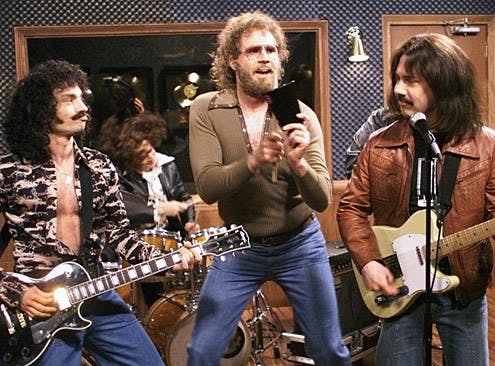Two middle-aged men walk into an elevator. The taller and heavier of the two points to the other’s t-shirt. It’s a Saturday Night Live t-shirt with a silkscreen silhouette of Will Ferrell in the “More Cowbell” sketch.
“Very nice,” he says. “Classic.”
The other guy, the one with a mostly white goatee beard wearing the Rush baseball cap, gives him a thumbs up.
“I know. One of the best.”
“Yes, it’s my favorite.”
“Where did you get it?”
“At the SNL store at 30 Rockefeller Center. I’m on vacation with my family.”
“Excellent. That’s a great buy. Can never have enough cowbell.”
It’s all about opportunity cost
The guy in the SNL t-shirt shrugs and says, “You’re right, but not really a good deal. It was $30 bucks out the door, but it’s a must have and we were there. Plus, if I had ordered it online and added in shipping costs, it might’ve been a wash, or maybe I would’ve saved. Who knows.”
The bigger guy winks then smiles and says, “Maybe, but that’s the price we pay for the opportunity cost, right?”
“You are correct,” I say. I was energized that this kind stranger gave me a economics reference with a lighthearted wink and a smile.
Opportunity cost, a core concept of economics that ensures we use limited resources wisely and choose accordingly, although there will always be a cost (not always monetary either) associated with not choosing the other choices other than the first one we choose, like a missed opportunity we’ll never know we missed.
Got that?
Like choosing a career path for the first time, or choosing a new job from a few offers (if you’re sought-after), or choosing the people you want to work for your business (if you’re in the people-choosing profession). Any way you slice it there’s an opportunity cost associated with these choices, one that you may never fully comprehend because there’s no way to get to the “what if’s” in the real world.
You can imagine and project based on Bureau of Labor Statistics data, salary data, population demographics, and other types of workplace market data readily available today. I mean, I could have been a civil engineer or an architect.
The highest level of employee satisfaction in 10 years
But that doesn’t matter now, and it doesn’t matter for any of us once we’ve progressed beyond choosing the career or the person to fill that career – at least, not until we choose again.
According to the latest Society for Human Resource Management (SHRM) 2015 Job Satisfaction and Engagement report, the choice rewards are up slightly and the opportunity cost down, with 86 percent of U.S. employees reporting overall satisfaction with their current job, an improvement of five (5) percentage points since 2013.
In fact, this percentage matches the highest level of satisfaction over the last 10 years, which was in 2009, and between 2009 and 2013 the levels of job satisfaction had gradually declined.
Plus, according to the same SHRM research, the top five contributors to employee job satisfaction in 2015 were:
- Respectful treatment of all employees at all levels;
- Trust between employees and senior management;
- Benefits, overall;
- Compensation/pay, overall;
- Job security.
Satisfied and engaged will also evangelize
Now, 26 percent of these respondents were Millennials, the soon to be (if not already) majority of the workforce. A PeopleFluent Millennials research report will come out in September (which you can pre-register for here), but in the meantime we’ve uncovered some early insights I think are worth sharing, and s0me of it aligns with the above SHRM research:
- Some 75 some say they’d leave their current job for better pay (isn’t that true for most of us?);
- Nearly 80 percent are more engaged when they have mentorship programs at work (respectful treatment and trust are born from these);
- More than 26 percent expect their next role is with an entirely new employer (ah, more opportunity costs).
We all know what happens to employer brands when the current employees aren’t satisfied and engaged – there’s a poison that seeps into the people pools and taints them for miles and miles.
But when they are satisfied and engaged, they will evangelize your company culture in an authentic, transparent way, something we discussed on the TalentCulture #TChat Show with Stacy Donovan Zapar, an 18-year recruiting veteran for Fortune 500 tech companies and Founder of Tenfold, a boutique recruiting consultancy and training firm.
We agreed that, although we all long for flexibility and fun, work is actually really hard at times. It will be stressful and mind-numbing and soul-sucking regardless if its full-time or contract work.
It helps to have a satisfying employer brand
But if those individuals and organizations who employ have an “satisfying” employer brand and offer fulfilling work experiences, it helps those who are seeking to choose a potentially better career path and a more rewarding job. And it helps those HR and recruiting professionals choose those who are seeking, rounding out that magical economic equation of supply and demand.
The part when you wink and smile and think opportunity cost be damned.
This was originally published on Kevin Grossman’s Reach West blog.
